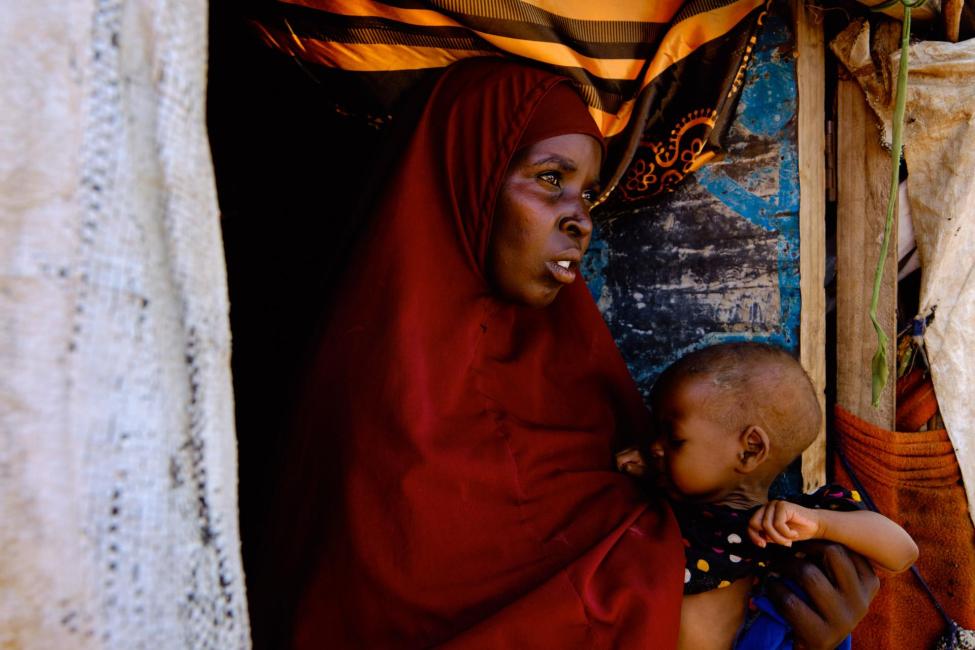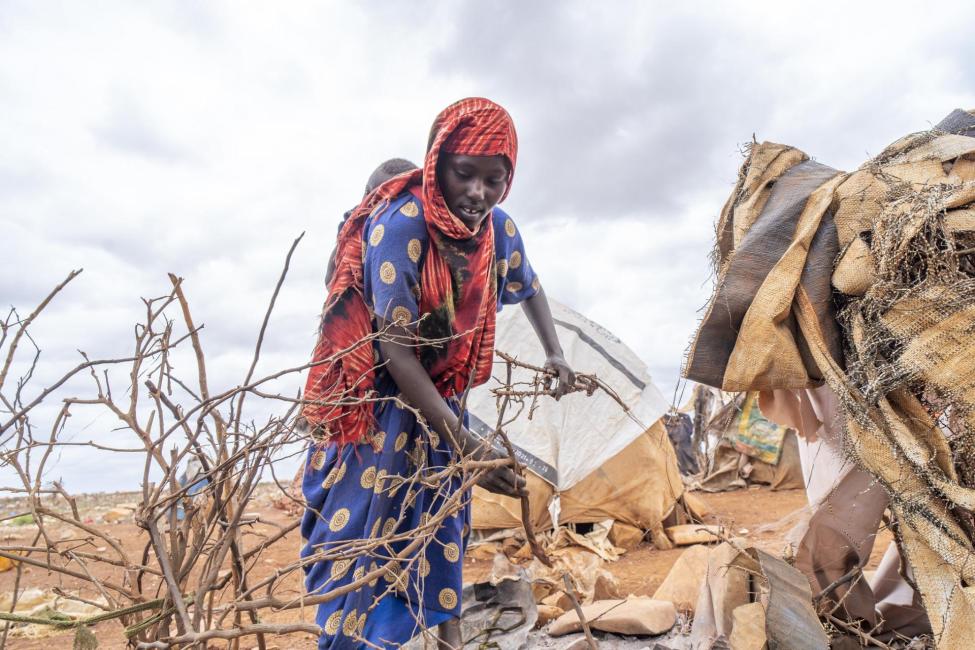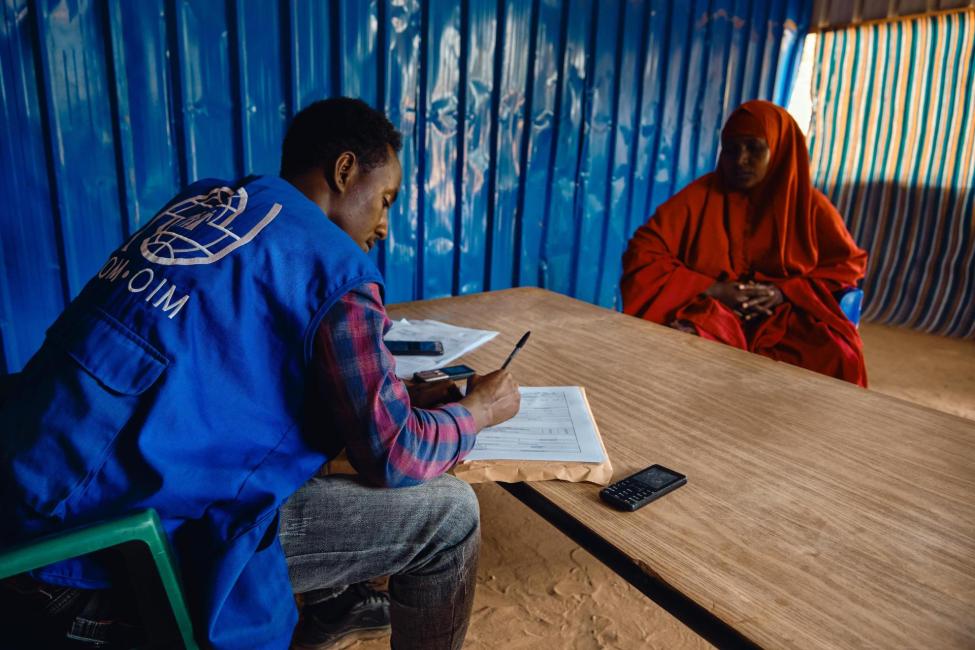-
Who We Are
WHO WE AREThe International Organization for Migration (IOM) is part of the United Nations System as the leading inter-governmental organization promoting since 1951 humane and orderly migration for the benefit of all, with 175 member states and a presence in over 100 countries. IOM has had a presence in Somalia since 2006.
About
About
IOM Global
IOM Global
-
OUR WORK
Our WorkAs the leading inter-governmental organization promoting since 1951 humane and orderly migration, IOM plays a key role to support the achievement of the 2030 Agenda through different areas of intervention that connect both humanitarian assistance and sustainable development. Across Somalia, IOM facilitates transition of Internally Displaced Persons (IDPs) and refugees towards durable solutions by providing services and support for Migrants and Mobile Populations.
Cross-cutting (Global)
Cross-cutting (Global)
- Data and Resources
- Take Action
- 2030 Agenda
Baidoa, Somalia - Nearly eleven months into a historic drought in Somalia, the situation for millions of people is far from getting better. In the city of Baidoa, located in one of the worst drought-affected regions in south-central Somalia, approximately 7,000 people arrive at sites for displaced people every week in dire need of help.
Those who make it to the sites have made agonizing decisions to risk the journey in their weakened state caused primarily by malnutrition, or to leave their most vulnerable family members – both old and young – in the hopes that they will survive.
“I came by foot; it took me almost five days. We sat in the shadow of trees during the day, waiting for the sun to set, then we walked at night,” said an elderly woman who has spent two months in a site for the displaced in Baidoa after her livestock died.
“We lost some of our children due to the drought,” said another displaced woman staying in Baidoa as her eyes filled with tears.
The human toll has been staggering and has touched everyone here. Sitting amongst a group, another woman adds, “We lost some of our children due to the drought,” as tears fill her eyes.
Desperately hoping to avoid the same fate for her child, 30-year-old Farhia admits, “I’m struggling to feed my son. He is sick, and I don’t know where to take him. Nobody is helping us,” The young mother then reveals a set of burn scars on her malnourished six-month-old son. Farhia had taken him to a traditional healer who practiced “Guboow” on the infant by pressing burning wood against his flesh to destroy the illness. In Somali, the word “Guboow” means scar burning.
Farhia has been living in Baidoa's informal settlements for nine months, yet no one has told her about the nearby health clinic. After Farhia shared the story of her son’s illness, camp management staff from the International Organization for Migration (IOM) put her in touch with Baidoa Hospital, who admitted him for treatment that day to treat a respiratory infection. Ten days later, Farhia’s son is greatly improved and is discharged.
Farhia’s inability to access the care she needed for her son is not an isolated case. Like her, many displaced persons are not aware of their rights or the services available to them.
The needs in Somalia are extraordinary given the fact that more than 1 million people have been internally displaced by drought, with 120,000 of them settling in Baidoa; new arrivals build makeshift shelters, expanding informal sites already hosting thousands of people displaced by conflict and climatic shocks.
For many, this is the first time they have had to abandon their homes and way of life. Others have been displaced multiple times because of evictions or lack of services in places where they had previously settled.
Most of the people arriving at Somalia's displacement sites are farmers who have only known a pastoral life of tending animals and crops for survival. Without modern amenities or access to the internet and mainstream media, their main source of information has always been neighbours, relatives, or travelers.
Amidst the chaos and trauma of losing their traditional lifestyle, displaced people face a new obstacle – accessing vital information including the ways and means to food, shelter, medical care and family unity.
“If it is the first time you are living in a site like this or even in this area, you do not know where to get information, what services are available and what you are entitled to, while humanitarian partners might not know that you have arrived. This is where camp management can close the information, service, and coordination gap,” said Benjamin Conner, coordinator for the Camp Management Cluster which is co-led by IOM in Somalia.
IOM runs camp management systems in nearly 500 displacement sites across the country that have received tens of thousands of people in Mogadishu, Doolow, Kismayo, Baidoa, Luuq, Beletweyne, Jalalaqsi and Bulo Burto.
The process begins as each person or family arrives. Camp managers identify each individual and collect information on their background so that partners understand the range of needs to ensure adequate care. While the process may seem straightforward, each displaced person has a unique set of complex needs to address, often requiring multiple partners or pathways to access help.
IOM then organizes information sessions to provide residents of the sites with information and guidance on their rights and services, including where to find health facilities, water sources and how to access food distribution. The sessions are facilitated by trained community members familiar with the humanitarian services in the area.
As a fail-safe mechanism, displacement site residents are also provided with information on how to express complaints or provide feedback and requests to aid organizations on specific needs. This is done through a help desk or a toll-free hotline to call that IOM runs.
For example, “This week a young woman came with her severely malnourished child asking for help,” said Rukia Mohammed, a member of the IOM team in Baidoa. “With the information she provided to the staff, we were able to refer her to the nutrition team who immediately screened the child and referred him to a UNICEF health clinic.”
Lack of food, water or shelter are the main complaints submitted by residents in the sites. The feedback system not only improves accountability, but also expedites relief. For instance, IOM can usually respond within 24 hours to refer people’s cases to local services and partners who can provide what is needed.
Another tenet of holistic camp management is enabling community mobilization and the participation of the displaced population. IOM also trains residents to become community mobilizers who spread important information through loudspeakers or by going door to door.
Inclusion in the daily life in the sites for the displaced cannot be underestimated. “People want to be engaged. Having local community members sharing information is the most effective way of providing information. They are trusted sources and understand the social dynamics as well as the needs,” said Rukia.
Unsurprisingly, with more than 3,000 displacement sites in Somalia alone, the needs are overwhelming camp management systems. IOM and partners manage 36 per cent of the sites, and due to limited funding are struggling to deploy more camp managers that can monitor and register new arrivals to help them tackle their necessities.
Displaced communities are often left outside the safeguards and stability of their homes and communities and come to sites as a last resort in search of safety, medical care, food, shelter and water. These sites may not provide a permanent solution but if well-managed, they can provide a temporary refuge where life-saving assistance can be provided.
When camp coordination and management support is not present, displaced people are forced to move again and again to find humanitarian assistance, often due to limited services or the lack of understanding about what is available due to poor information sharing.
IOM urgently needs USD 12.5 million to expand its camp management services and ensure this life-saving support can reach those who need it most.
Nearly 400,000 newly displaced persons have benefited from guidance and information through on-site staff since the start of 2022. Thanks to the presence of camp managers, another 33,707 families affected by drought have been registered to receive water, food, shelter, health screening, and hygiene items.
More than 7 million people in Somalia face extreme levels of hunger with more than 1 million people internally displaced, and at least 3 million livestock have died from drought conditions. IOM operates one of the biggest humanitarian responses in Somalia and is committed to helping communities survive and recover from the drought. In 2022, IOM reached over 700,000 people with life-saving assistance. We can reach more with your donation: Donate.
Text by Claudia Rosel, Media and Communications Officer, IOM Somalia, cbarrios@iom.int



